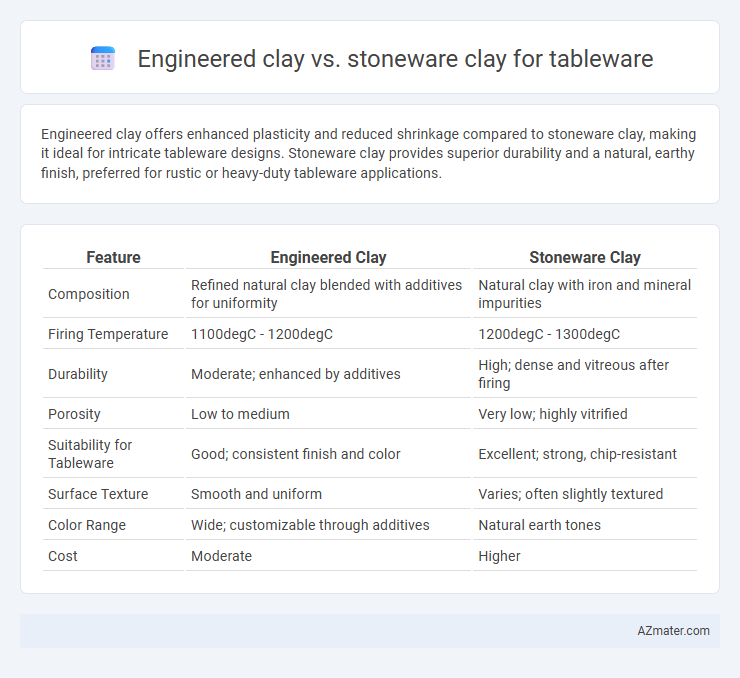Engineered clay offers enhanced plasticity and reduced shrinkage compared to stoneware clay, making it ideal for intricate tableware designs. Stoneware clay provides superior durability and a natural, earthy finish, preferred for rustic or heavy-duty tableware applications.
Table of Comparison
| Feature | Engineered Clay | Stoneware Clay |
|---|---|---|
| Composition | Refined natural clay blended with additives for uniformity | Natural clay with iron and mineral impurities |
| Firing Temperature | 1100degC - 1200degC | 1200degC - 1300degC |
| Durability | Moderate; enhanced by additives | High; dense and vitreous after firing |
| Porosity | Low to medium | Very low; highly vitrified |
| Suitability for Tableware | Good; consistent finish and color | Excellent; strong, chip-resistant |
| Surface Texture | Smooth and uniform | Varies; often slightly textured |
| Color Range | Wide; customizable through additives | Natural earth tones |
| Cost | Moderate | Higher |
Introduction to Engineered Clay and Stoneware Clay
Engineered clay for tableware is specially formulated with a controlled mix of raw materials to achieve consistent plasticity, strength, and firing characteristics, making it ideal for precision and repeatability in production. Stoneware clay, a natural clay with a high concentration of feldspar and silica, is valued for its durability, vitrification at high firing temperatures, and its ability to produce dense, non-porous tableware resistant to chipping. Both clays serve distinct purposes in tableware manufacture, with engineered clay offering customization for industrial processes and stoneware providing traditional robustness and aesthetic appeal.
Composition and Material Differences
Engineered clay for tableware typically consists of refined kaolin, ball clay, feldspar, and quartz, offering a smooth, plastic texture that enhances moldability and firing strength. Stoneware clay contains a higher percentage of natural minerals such as feldspar, quartz, and mica, resulting in a denser, non-porous, and durable material ideal for everyday use and high-temperature firing. The primary difference lies in engineered clay's controlled composition for uniformity and performance, while stoneware clay relies on raw mineral content for its robust mechanical properties and rustic aesthetic.
Manufacturing Process Comparison
Engineered clay for tableware is formulated with precise mineral blends to enhance plasticity and reduce firing shrinkage, enabling consistent mass production and uniform product quality. Stoneware clay, often derived from natural deposits, requires careful processing to remove impurities and achieve the right particle size, which can introduce variability in firing temperature and consistency. The engineered clay manufacturing process integrates controlled grinding, mixing, and deflocculation, while stoneware involves traditional refining techniques that may result in slower production cycles and less predictable mechanical strength.
Durability and Strength in Tableware
Engineered clay offers enhanced durability and reduced porosity, making it highly resistant to chipping and cracking in daily tableware use. Stoneware clay boasts exceptional strength and can withstand thermal shock, ensuring long-lasting performance for plates and bowls. Both materials deliver sturdy tableware, but engineered clay's tailored composition provides superior mechanical resilience and consistency.
Thermal Shock Resistance
Engineered clay exhibits superior thermal shock resistance compared to stoneware clay, making it ideal for tableware exposed to rapid temperature changes. Its optimized composition enhances durability and reduces the risk of cracking when transitioning between hot and cold environments. Stoneware clay, while robust, generally has lower tolerance for thermal shock, increasing the likelihood of damage during everyday use.
Aesthetic Qualities and Surface Finish
Engineered clay offers a smooth, uniform texture with vibrant coloration ideal for contemporary tableware designs, enhancing aesthetic appeal through precise control over material composition. Stoneware clay provides a natural, earthy finish with subtle variations and a rustic charm, featuring a durable surface that often includes speckling or grog for tactile interest. Both materials deliver excellent surface finishes, with engineered clay favoring sleek, polished looks and stoneware excelling in organic, textured appearances suitable for artisanal tableware.
Porosity and Water Absorption Rates
Engineered clay for tableware typically exhibits lower porosity and water absorption rates compared to traditional stoneware clay, enhancing durability and stain resistance. Stoneware clay, while robust, tends to have higher porosity, allowing greater water absorption which can lead to increased susceptibility to cracking and bacterial growth. Optimizing porosity in engineered clay results in tableware that is more hygienic and better suited for everyday use.
Safety and Food Compatibility
Engineered clay offers enhanced food safety due to its controlled composition, reducing the risk of harmful contaminants leaching into tableware. Stoneware clay, known for its durability and natural mineral content, is vitrified at high temperatures, ensuring non-porosity and excellent food compatibility without toxins. Both materials meet safety standards, but engineered clay provides more consistent results in preventing chemical interactions with food.
Environmental Impact and Sustainability
Engineered clay for tableware typically has a lower environmental impact due to its efficient raw material use and reduced energy consumption during firing compared to stoneware clay, which often requires higher temperatures and longer kiln cycles. Sustainability in engineered clay is enhanced through the incorporation of recycled materials and improved manufacturing processes that minimize waste and carbon emissions. Stoneware clay, while durable and long-lasting, generally has a larger carbon footprint and greater resource extraction demands, making engineered clay a more eco-friendly choice for sustainable tableware production.
Cost, Availability, and Market Trends
Engineered clay offers lower production costs and consistent quality, making it a cost-effective choice for mass-produced tableware compared to stoneware clay, which tends to be pricier due to natural resource extraction and firing processes. Engineered clay benefits from widespread availability through industrial suppliers, while stoneware clay availability is more limited and region-specific, impacting supply chains and pricing. Market trends indicate a growing demand for eco-friendly and artisanal stoneware tableware, driving up its value despite higher costs, whereas engineered clay dominates in commercial settings due to scalability and affordability.

Infographic: Engineered clay vs Stoneware clay for Tableware
 azmater.com
azmater.com